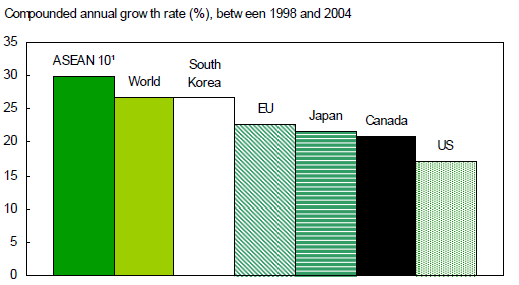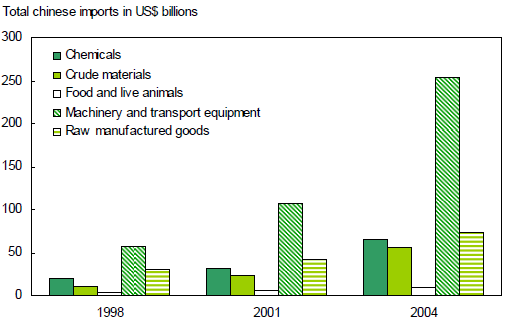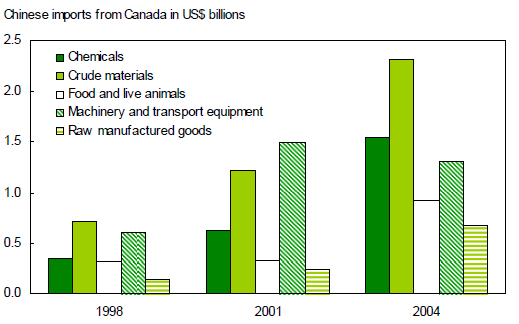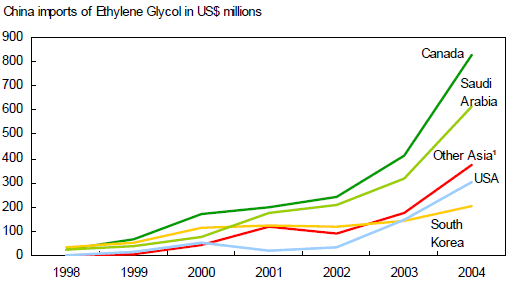Common menu bar links
Feeding the Dragon: Canadian Exporters and a Booming China
Archived Content
Information identified as archived is provided for reference, research or recordkeeping purposes. It is not subject to the Government of Canada Web Standards and has not been altered or updated since it was archived. Please "contact us" to request a format other than those available.

by Steve Grunau, International Trade Division
Summary
Feeding the dragon: A huge demand for imports
Organic chemicals fastest growing Canadian export commodity
Wood pulp leading export product to China
Strong Chinese demand pushes up prices and value of metal
exports
Wheat: China re-emerged as top export market
Key to the future: The nature of China’s economic growth
Summary
China’s scorching economy has been one of the key economic stories of the last 10 years. The People’s Republic of China is now the world’s sixth largest economy, and the third largest trading nation, behind the United States and Germany.
It has also become a global manufacturing centre, as companies the world over shift production there to take advantage of low wages and a potential market of 1.3 billion people, including a burgeoning middle class with more and more money to spend.
Just where does Canada fit into this picture? This study, which examines China’s principal imports from Canada between 1998 and 2004, shows, that some Canadian businesses are indeed reaping the benefits of the rapid economic growth in China. The Asian giant is buying Canadian products at a record pace.
Since most Canadian firms do not specialize in manufacturing machinery or the kinds of components that Chinese factories assemble into finished products, they haven’t been significant sources of Chinese imports from Canada.
Rather, the study shows that Canadian businesses have achieved strong sales growth in other areas of high Chinese demand such as natural resources. Exporting companies in niche resource industries are benefiting the most.
The leading sources of growth in Chinese imports from Canada have been crude materials, where growth was driven by rising sales of wood pulp, metals and fertilizer. Chinese imports of Canadian crude materials have more than tripled since 1998, accounting for nearly one-third of total growth in Canadian exports to China.
Growing demand in China for raw materials to fuel its export industries and satisfy rising domestic consumption has raised global commodity prices. This has increased revenue in Canadian resource industries such as metals by increasing the value of exports not only to China, but also to major customers such as the United States.
The fastest growth of all commodities exported to China has been in exports of organic chemicals, used in China to make polyester. At the same time, Canadian firms have profited from rising Chinese imports of iron ore and nickel, key ingredients in steel production. Also, our wheat exports to China rebounded in 2004 after a long period of decline.
Canada’s economy relies heavily on trade; our exports alone account for more than a third of our gross domestic product. While over four-fifths of our exports head south to the United States each year, China has become the fourth largest market for Canadian exports behind the United States, Japan and the United Kingdom.
In total, Chinese imports from Canada have more than tripled since 1998, rising at an average annual rate of 21%. Nevertheless, in 2004, China’s imports of Canadian goods, worth US$7.0 billion,1 accounted for only 1.3% of China’s total imports. To put that into perspective, China imported over US$94 billion from Japan alone in 2004.
Note to readers
Most of the data used in this study come from the United Nations Comtrade database, and includes trade with the People’s Republic of China (excluding Hong Kong and Macao). The UN compiles and standardizes trade data from many countries, including Canada, to facilitate international comparisons.
This database allows for the calculation of Canada’s share of Chinese imports, and comparison with the shares of other countries. Since the data are compiled by the UN according to its own standards, Statistics Canada cannot verify whether our standards are met. Moreover, unless otherwise specified, all amounts are expressed in US dollars.
Statistics Canada also calculates the value of Canadian exports to China based on Canadian customs data. There are substantial differences between these figures and UN estimates of Chinese imports from Canada, which are based on Chinese customs data.
Joint reconciliation studies conducted by Statistics Canada and the Customs General Administration of China found that reported Chinese imports from Canada were on average 30% higher than Canadian exports to China between 1998 and 2003. (See Sandra Bohatyretz and Bruna Santarossa, ‘Merchandise Trade Reconciliation Study: Canada-China, 2002 and 2003’Canadian Trade Review no. 3, August 16, 2005, Statistics Canada Catalogue no. 65-507-MWE2005003.)
One reason behind these differences is that Canadian exporters may not know, or may not accurately report the final destination of their goods leaving the country. As a result, products may be exported to Hong Kong, stored in a warehouse, and then re-exported to China. Canadian customs would report these as exports to Hong Kong, while China would report them as imports from the country of origin, Canada.
The reconciliation study found that indirect trade, mostly through Hong Kong, was the largest single cause of discrepancies between Canadian export and Chinese import data.
Feeding the dragon: A huge demand for imports
China’s soaring economic growth during the past decade has helped to shore up other economies by sparking a huge demand for commodities, thereby driving up prices. According to Chinese authorities, real gross domestic product increased 9.6% a year on average over the last 25 years.2
Chinese exports nearly tripled from US$63 billion in 1990 to US$184 billion in 1998. By 2004 they had tripled again, hitting US$593 billion. Given its competitive advantage in manufactured goods, China has scoured the world for raw materials, parts and factory machinery to feed its manufacturing industries. As a result, its imports quadrupled from US$140 billion in 1998 to US$561 billion in 2004.
Imports from China’s neighbours growing the fastest

1. Association of Southeast Asian Nations which includes Brunei Darussalam, Cambodia, Indonesia, Laos, Malaysia, Myanmar, Philippines, Singapore, Thailand and Vietnam.
Source: International Monetary Fund, Direction of Trade Statistics.
The biggest winners have been China’s neighbours. While, Japan continues to be the leading supplier of goods to China, accounting for US$94 billion, or about 17% of Chinese imports in 2004, it is South Korea and the countries of Southeast Asia that have benefited the most from China’s growth.
South Korea has surpassed the United States to become the third largest source of Chinese imports in 2004.3 Chinese imports from South Korea hit US$62 billion in 2004, or over four times the value of its exports to China in 1998. Exports from Southeast Asian countries, including Malaysia, Singapore and Thailand, grew at an even faster rate; combined, they exported nearly US$61 billion to China in 2004.
These countries have taken advantage of growth in Chinese machinery and equipment imports, which are an integral part of China’s rise as a global manufacturing centre. As a result of its lower labour costs, China has become an important part of global manufacturing supply chains, importing components which are then assembled into finished products for export.
Imports of machinery and equipment have accounted for nearly half of the rise in Chinese imports since 1998.4 This category would include imported electrical components that are later assembled into finished products in Chinese factories, as well as the machines needed to run the factories themselves. While South Korea and Southeast Asia are the newest players in China’s imports of machinery and equipment, Japan, Taiwan and the European Union maintain a significant share of this sector.
Since 1998, exports from the European Union to China have more than tripled, hitting US$71 billion in 2004. While the growth in US exports to China was slower, the United States accounted for US$45 billion, or 8%, of Chinese imports in 2004.
China’s rapid growth also presents an opportunity for Canadian exporters to help supply expanding Chinese industries, and the evidence shows Canadian businesses are benefiting.5
Between 1998 and 2004, Canadian exports to China more than tripled to more than US$7 billion, with annual growth since 1998 averaging 21%. Given that Canada’s exports to the world (in US dollars) grew by less than 7% a year on average over the same period, China has emerged as an important source of growth for Canadian exporters. In 2004, Canada was China’s 16th largest source of imports; still, it accounted for only 1.3% of the Chinese import market.
Total Chinese imports dominated by machinery and equipment...

Source: United Nations, UN Comtrade Database.
...while imports from Canada led by crude materials

Source: United Nations, UN Comtrade Database
The following sections take an in-depth look at Chinese imports from Canada during the past seven years.
Organic chemicals fastest growing Canadian export commodity
Organic chemicals have been the fastest growing Canadian export commodity to China, responsible for 17% of total export growth since 1998. By 2004, Canadian exports of these chemicals had grown to 30 times the levels in 1998.
Most of these exports consisted of ethylene glycol, a key industrial chemical used, among other things, to produce polyester in the apparel industry. Chinese factories have more than doubled their exports of apparel since 1998. One factor in recent years has been the phasing out of international quotas on apparel from China in accordance with an agreement under the World Trade Organization.6
China’s imports of ethylene glycol have grown to nearly 23 times their levels in 1998. Canada has emerged as the leader in this market in China, quadrupling its share of Chinese ethylene glycol imports from 0.9% in 1998 to 3.8% in 2004, an impressive achievement given the rapid growth in Chinese imports.
While Saudi Arabia, the United States and Taiwan also increased their share of the Chinese import market, Japan and South Korea both lost ground.
The booming Chinese demand has been responsible for 95% of the growth in Canadian exports of ethylene glycol since 1998. China continued to drive growth in Canadian exports of ethylene glycol in 2005. Canadian trade data indicates that exports of this chemical to China rose by an additional 19% last year.
The benefits of this growing chemical trade with China have been concentrated in Alberta, which makes most of Canada’s ethylene glycol.
As Chinese imports soar, Canada emerges as primary source of Ethylene Glycol

1. Other Asia consists of Asian countries not specified elsewhere in the UN database, including Taiwan, which is not a member of the UN and as such is not listed separately.
Source: United Nations, UN Comtrade Database.
Wood pulp leading export product to China
While chemicals have been Canada’s fastest-growing export commodity to China, wood pulp is our leading export product. Wood pulp exports have soared on the strength of increasing demand in China, centred in this case in the burgeoning Chinese paper industry.
Pulp exports provide a textbook example of how economic growth in China can create opportunities for nations that export the raw materials needed to fuel Chinese industries.
Chinese production of paper and paperboard has more than doubled since 1998. However, due to high domestic consumption, which in 2003 accounted for 16% of global demand, China is still a net importer of paper products.7
Dramatic growth in the Chinese paper industry has also increased demand for raw materials: waste paper, wood pulp and straw. Over-reliance on straw, which creates about 10 times the pollution that wood pulp does, has helped make the paper industry a leading source of water pollution in China.8
As a result, the Chinese government is turning to alternative raw materials, such as waste paper and wood pulp, to ease the impact of the paper industry on the environment, and is aiming to increase the use of wood pulp from 20% of paper inputs to around 60%.9 To achieve this target, China is hoping to rely on domestic plantation forests, but may need to supplement these with increased imported pulp.10
The elimination of tariffs on wood pulp imports, in compliance with China’s WTO commitments, has helped spark a dramatic increase in pulp imports, which have nearly quadrupled since 1998, with Canadian exports also rising sharply. Canadian pulp exports to China have shot up from US$251 million in 1998 to US$965 million in 2004. They accounted for nearly 13% of our total exports to China in 2004. China has now become Canada’s number two export market for wood pulp behind the United States. China overtook Japan in 2002.
Despite rapid growth, Canada has lost the once dominant position it held in China in this sector in 1993, when it accounted for one third of total pulp imports. Since then, Indonesia, Russia and Brazil have made substantial gains.
Canadian pulp exports to China rising...

... while market share has fallen

To limit the environmental impact of its paper industry and manage domestic demand for wood pulp, China recently announced restrictions on the export of wood pulp, and of paper made with imported pulp, that will take effect in 2006. It is uncertain whether this will effectively restrain growth in paper production, which some analysts have predicted will increase by another 30% to 60% by 2010.11
The state-owned China Paper Group recently bought a bankrupt pulp mill near Prince Rupert, B.C., which it plans to re-open with an investment of CAN$100 million.12 This could be interpreted as a sign that Chinese firms believe Canada will remain an important source of pulp imports in the future.
In the shorter term, however, it appears that in a rush to bring new production facilities on line, Chinese paper-makers have increased production too quickly for demand to keep up, resulting in an over-supply of paper.
Demand and prices for inputs to paper production, including wood pulp, have faltered, and imports slowed in 2005. As a result, Canadian pulp exports to China dropped by 12% last year, while Canadian pulp exports to other destinations declined by a more modest 5%.
Strong Chinese demand pushes up prices and value of metal exports
China’s emergence as a global manufacturing centre has increased its demand for the base metals used to produce steel and finished products. This trend has been reinforced by the rapid growth of urban areas in China, as the need for new infrastructure has helped fuel construction, and consequently, the demand for steel. China now produces and consumes one-third of the world’s steel.
Growth in the Chinese steel industry has been a boon for Canadian exporters. Canadian firms have profited from increased Chinese imports of iron ore and nickel, key ingredients in steel production. Canada is now the leading exporter of nickel to China.
However, rising prices, driven by Chinese demand, have proved even more beneficial to Canada’s metals industry, as revenue from sales to key customers such as the United States have also risen.
Nickel is a key ingredient in the production of stainless steel, and rapid growth in Chinese nickel imports have made it the third largest importer of nickel, behind the United States and Germany.
Canada has taken advantage of this growth, and has overtaken Russia to become the leading exporter of nickel to China. Our exports, which quadrupled between 2002 and 2004 to US$326 million, now account for 28% of total Chinese imports.
However, the doubling of Canadian nickel export prices since 2002 has triggered a much larger gain in the value of Canadian nickel exports. Export revenue rose from just over US$770 million in 2002 to about US$2.0 billion in 2004. The price gain has been due in no small part to rising Chinese nickel demand, which is straining global supplies. China currently accounts for a relatively small proportion of our nickel exports, with the United States purchasing the lion’s share.
Increased Chinese demand spikes price, value of Canadian nickel exports

China is now the world’s leading importer of iron ore, another key input to steel production. It accounted for 45% of world iron ore imports in 2004. Perhaps more importantly, China was responsible for 70% of the growth of world imports of iron ore between 1998 and 2004, making it a key customer for mining firms looking to expand their business.
Canada did not figure as significantly in Chinese iron ore imports, which were dominated by India, Australia and Brazil. But growing Chinese demand helped drive up Canadian export prices for iron ore by 16% in 2004 alone.
Increased Canadian exports to China, which now account for 10% of total Canadian iron ore exports, helped offset a decline in our exports to other markets.
Canadian exports of iron ore and concentrates to China more than doubled in 2005 on the strength of increasing volume and rising prices.
Wheat: China re-emerged as top export market
China has re-emerged as a top export market for Canadian wheat. This rebound was a welcome turnaround from a long period of decline in Canadian wheat exports to China, which until 2004 had fallen almost every year since 1995.
Record wheat harvests in China between 1996 and 1999 created a ballooning surplus, as China’s yield per hectare of land skyrocketed to all-time highs and domestic supply exceeded demand. This led to a sharp decline in Chinese imports. However, decreased Chinese production finally depleted those surpluses, and China turned again to foreign sources to meet demand.
After falling to just US$36 million in 2003, Canadian exports to China soared in 2004 to just over US$600 million, the highest level since 1996. Canada was the second largest supplier of wheat to China in 2004, just behind the United States.
Wheat used to be a mainstay of Canada-China trade, accounting for one-third of our China-bound exports in 1993. China has historically been a significant customer of the Canadian Wheat Board, which handles export marketing on behalf of Canadian wheat growers.
Chinese wheat production fell below consumption in 2000, as the number of hectares planted with wheat was substantially reduced. Instead of increasing imports to meet the demand, China opted to use existing wheat stocks, which had ballooned during the years of surplus production.
Poor Canadian wheat harvests in 2002 and 2003, resulting from drought in the Prairies, further hampered Canada’s capacity to meet Chinese demand for imports, which by 2003 had begun to rise. By 2004, when Canadian production had recovered and Chinese imports were beginning to increase, cereal exports once more became an important aspect of Canada-China trade.
As a result of increased yields and rising domestic production, China’s 2005 wheat imports were expected to be substantially lower than in 2004.13 While data on Chinese wheat imports for 2005 are not yet available, this decline was reflected in Canada’s 2005 wheat exports to China, which were down by over 60% compared with 2004.
The Canadian Wheat Board notes that increasing competition from smaller wheat exporters such as Russia may squeeze prices downward over the next few years.14 How Canada fares in the Chinese market will depend in part on its ability to contend with these players, as well as with its traditional competitors, the United States and Australia.
Key to the future: The nature of China’s economic growth
What does the future hold for Canada’s trade with China? Much depends on the nature of China’s economic growth.
Backlogs of giant cargo ships and oil tankers outside China’s ports point to the need to maintain adequate infrastructure to facilitate economic and trade growth. Future growth could worsen China’s existing transport and energy bottlenecks.15 The Chinese government is taking steps to address these difficulties, having announced plans to increase capacity at the port of Shanghai.
On the home front, drumming up business with China has been a priority during the past decade for Canada’s federal and provincial governments, which have sponsored numerous trade missions to the huge Asian market.
The Canadian government in October 2005 announced its intention to invest in a Pacific Gateway strategy to improve transportation infrastructure and otherwise facilitate trade links with Asia.
China’s energy imports have traditionally come from the Middle East, Russia and Africa. However, plans to build a pipeline that could load tankers on Canada’s west coast may allow Canada to emerge as an alternative source to meet China’s demand for energy.
Time will tell how Canadian companies’ search for new opportunities will shape the nature of our future exports to China.
Footnotes
- Since the main source for this paper is the UN Comtrade database, unless otherwise specified, all amounts in the paper are expressed in US dollars.
- Bloomberg, ‘China may overtake France in economy’, China Daily, (accessed February 3, 2006).
- While the EU exported more to China than did South Korea in 2004, South Korea’s exports were more than double that of any single EU country. The IMF no longer identifies Chinese imports from Taiwan, but includes these in the total imports from Asia. However, the Chinese Ministry of Commerce indicates that China imported just under US$65 billion in merchandise from Taiwan in 2004, slightly more than from South Korea.
- The System of International Trade Classification (SITC) Rev. 3 divides products into ten chapters, five of which are significant in Canadian exports to China: Food and live animals, Crude materials (inedible products that have not been manufactured, excluding fuels), Chemicals (including raw chemicals, plastics and pharmaceuticals), Raw manufactured goods (classified chiefly by the material they are made of, such as steel), and Machinery and transport equipment. The other five categories of which Canada exports little to China are Beverages and tobacco, Mineral fuels, Animal and vegetable oils, Manufactured articles (for example, furniture) and the catch-all Other category.
- According to a recent Statistics Canada study, Canadian exports to China grew faster than our imports from there in 2004. See ‘Canada’s Trade and Investment with China,’ Canadian Economic Observer, June 2005, Statistics Canada, Catalog no. 11-010-XIB.
- For more information on recent shifts in world trade in textiles and clothing and their effects on Canadian industries, see Diana Wyman, ‘Stretching or Shrinking? The Textile and Clothing Industries in Canada,’ Analysis in Brief, March 2005, Statistics Canada, Catalogue no. 11-621-M2005022, (accessed February 3, 2006).
- According to statistics cited in Asia Pacific Foundation of Canada (APFC), ‘Positioning Canada in China’s Paper Chase,’ Asia Pacific Bulletin #147, February 27, 2004, (accessed February 3, 2006).
- According to the State Environmental Protection Agency, cited in Sun Xiaohua, ‘New tech urged to abate paper making pollution’ (on-line), China Daily, November 1, 2005, (accessed February 3, 2006).
- Asia Pacific Foundation of Canada, ‘Positioning Canada in China’s Paper Chase,’ Asia Pacific Bulletin #147, February 27, 2004, (accessed February 3, 2006).
- Ibid.
- D. He and C. Barr, ‘China’s pulp and paper sector: An analysis of supply-demand and medium-term projections,’ International Forestry Review, Vol. 6 (3-4), 2004.
- Asia Pacific Foundation of Canada, n.d. ‘China: market overview’, 2005, (accessed February 3, 2006).
- United States Department of Agriculture, ‘Grain: World Markets and Trade,’ Foreign Agricultural Service Circular Series, FG 12-05, December, 2005, (accessed February 3, 2006).
- Canadian Wheat Board, ‘CWB grain production and trade forecast to 20011-12’, (accessed February 3, 2006).
- Yanping Li, ‘Beijing may expand efforts to cool economy’, International Herald Tribune, January 27, 2005, (accessed February 3, 2006).

